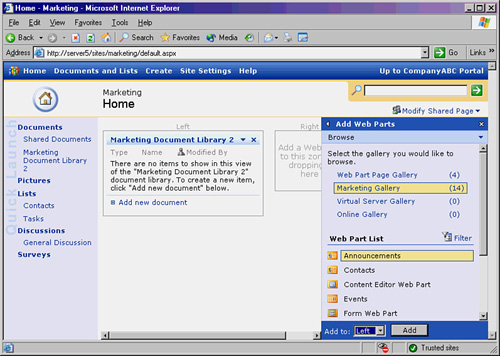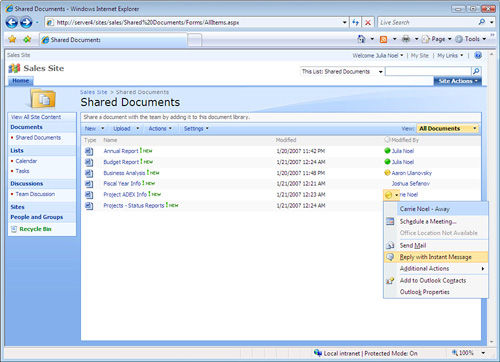Answering
the question “What is SharePoint 2010?” is not an easy task. This is
primarily because, unlike many of the other Microsoft tools on the
market, SharePoint is designed to be a platform that can be molded and
shaped to fit the needs of virtually any organization. One SharePoint
environment may look drastically different than another SharePoint
environment and may be used for completely different tasks.
Indeed, SharePoint is designed to
be customized to solve individual business problems and to satisfy
specific organizational needs. It is built to serve as a full-fledged
document management solution, collaboration portal, team site workspace,
public-facing website, extranet partner collaboration environment, or
all these things at the same time.
SharePoint 2010 has evolved
over the years from a disparate set of small-scale tools into a complex
and capable tool in use at a large proportion of organizations in the
world. But where did SharePoint 2010 come from? Before understanding
what this version is, it is first important to gain a better
understanding of the history of SharePoint products and technologies and
how we got where we are today.
Exploring the SharePoint 1.0 Wave: SharePoint Team Services and SharePoint Portal Server 2001
SharePoint as we know it today
had its roots in two distinct products developed by two different teams
at Microsoft. These products overlapped in many areas, but during the
development phases, they were seen as completely different products and
were expected to have different names upon release. It was only as the
release date approached that Microsoft decided to give each the name
SharePoint, even though they were different in many ways.
The first of these two
products became SharePoint Team Services and was seen as a team
collaboration product with limited document management functionality.
This product was released as an add-on to the FrontPage media, which is
how many administrators stumbled upon it eventually. Although unique in
approach, it wasn’t very scalable and was limited in functionality. The
letters STS still can be found in today’s product line, such as in the
STSADM tool.
The second product
developed by Microsoft eventually became SharePoint Portal Server (SPS)
2001 and was seen as an extension to public folder functionality in
Microsoft Exchange Server. The storage engine for SPS 2001 was the
Microsoft Exchange jet engine database, which was completely different
than the SQL Server based back-end of SharePoint Team Services.
Although innovative and
providing some interesting and powerful features, these two versions of
SharePoint did not see too much use in most organizations, aside for the
occasional team site put together by scattered departments and an
occasional portal.
Exploring the SharePoint 2.0 Wave: Windows SharePoint Services 2.0 and SharePoint Portal Server 2003
Microsoft’s first real attempt
to marry these two tools into a single product line and create a true
collaboration environment was born out of the second wave of SharePoint
technologies, SharePoint 2003, as shown in Figure 1.
SharePoint Team Services was rebranded as Windows SharePoint Services
(WSS) 2.0, and the portal product became SharePoint Portal Server 2003.
Both products were built on the same SQL Server database engine, and
Microsoft positioned the features to be an extension of each other. WSS
was the “free” product, available with every license of Windows Server,
whereas the SPS 2003 product became the fully featured portal that
incorporated WSS sites into its topology.

Although it was a great
effort, and a much more mature product than the 2001 line of SharePoint
products, growing pains were still visible in the software. For many
people, it wasn’t quite clear whether to use SPS 2003 Areas or WSS
Sites, and the integration was loose. This wave saw the first strong
adoption of SharePoint, however, as many organizations deployed it for
the first time.
Exploring the SharePoint 3.0 Wave: Windows SharePoint Services 3.0 and Microsoft Office SharePoint Server 2007
The point at which Microsoft
SharePoint products and technologies really took off was the 3.0 wave.
This wave saw the tightest integration between the new versions of the
two products. WSS became WSS 3.0, and SPS 2003 was renamed Microsoft
Office SharePoint Server (MOSS) 2007. In addition, Microsoft combined
its Content Management Server product with SharePoint, integrating it
into MOSS 2007.
MOSS 2007 and WSS 3.0, as shown in Figure 2,
saw massive adoption across the board, and many organizations started
to deploy for collaboration, document management, intranets, and
extranets. In addition, major industry websites started to move to
SharePoint 2007, with tens of thousands of public-facing sites deployed
on SharePoint within the first few years. This version saw true
comprehensive document management, enterprise search, and collaboration
capabilities as well, and many organizations deployed it to improve
their efficiency and communications capabilities.

SharePoint 2007’s success was
one of its disadvantages as well, unfortunately, as the growth of
SharePoint sites led in some cases to a proliferation of siloed
SharePoint farms and sites in many spots across organizations. There was
a general lack of governance of the SharePoint environments, and this
ended up hurting many companies as it created redundancy of data and
inefficiencies. In addition, there were certain features that were asked
for that were not part of the product, and other annoyances that people
complained about that Microsoft sought to fix. Organizations looked to
Microsoft to further improve its product, and Microsoft busily gathered
information on what people liked and didn’t like to include those new
features in the next release of the product.
Exploring the Latest SharePoint 4.0 Wave: SharePoint Foundation Server and Microsoft SharePoint Server 2010
Early
in 2010, Microsoft released its next wave of SharePoint products:
SharePoint 2010. WSS was renamed once again, this time to SharePoint
Foundation Server, and the Office in MOSS was dropped, with the product
simply renamed Microsoft SharePoint Server 2010. A significant number of
new features found their way into these two products, as will be
demonstrated in this book. Organizations looking to effectively leverage
the capabilities of SharePoint should first gain a good understanding
of what those features are and understand how they can be matched to
address specific business needs within their organization.